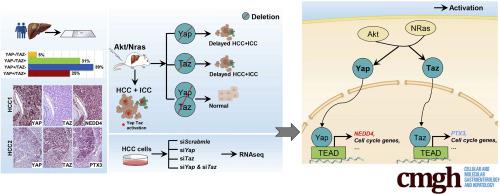Cellular and Molecular Gastroenterology and Hepatology ( IF 7.1 ) Pub Date : 2020-11-21 , DOI: 10.1016/j.jcmgh.2020.11.008 Haichuan Wang 1 , Jingxiao Wang 2 , Shanshan Zhang 3 , Jiaoyuan Jia 4 , Xianqiong Liu 5 , Jie Zhang 3 , Pan Wang 3 , Xinhua Song 3 , Li Che 3 , Ke Liu 6 , Silvia Ribback 7 , Antonio Cigliano 8 , Matthias Evert 8 , Hong Wu 9 , Diego F Calvisi 8 , Yong Zeng 9 , Xin Chen 3

|
Background & Aims
Yes-associated protein (YAP) and its paralog transcriptional co-activator with post synaptic density protein, drosophila disc large tumor suppressor and zonula occludens-1-binding motif (TAZ) are 2 co-activators downstream of Hippo tumor-suppressor cascade. Both have been implicated in the development of hepatocellular carcinoma (HCC). However, whether YAP and TAZ have distinct or overlapping functions during hepatocarcinogenesis remains unknown.
Methods
Expression patterns of YAP and TAZ were analyzed in human HCC samples. The requirement of Yap and/or Taz in protein kinase B (Akt)/ neuroblastoma RAS viral oncogene homolog (NRas) -driven liver tumorigenesis was analyzed using conditional Yap, Taz, and Yap;Taz knockout mice. Transcriptional programs regulated by YAP and/or TAZ were identified via RNA sequencing.
Results
We found that in human HCC samples, an almost ubiquitous activation of YAP or TAZ occurs, underlying their role in this tumor type. Intriguingly, 70% of HCC samples showed only nuclear YAP or TAZ immunoreactivity. In the Akt/NRas liver tumor model, where nuclear Yap and Taz can be detected readily, deletion of Yap or Taz alone only mildly delayed liver tumor development, whereas their concomitant ablation strongly inhibited tumor cell proliferation and significantly suppressed Akt/NRas-driven hepatocarcinogenesis. In HCC cell lines, silencing of either YAP or TAZ led to decreased expression of both overlapping and distinct sets of genes, with the most prominent gene signatures related to cell-cycle progression and DNA replication.
Conclusions
YAP and TAZ have overlapping and distinct roles in hepatocarcinogenesis. HCCs may display unique activation of YAP or TAZ, thus relying on either YAP or TAZ for their growth.
中文翻译:

河马效应子 YAP 和 TAZ 在人和小鼠肝癌发生过程中的独特和重叠作用
背景与目标
Yes 相关蛋白 (YAP) 及其旁系同源转录共激活因子与突触后密度蛋白、果蝇椎间盘大肿瘤抑制因子和 zonula occludens-1 结合基序 (TAZ) 是 Hippo 肿瘤抑制级联下游的 2 个共激活因子。两者都与肝细胞癌(HCC)的发展有关。然而,YAP 和 TAZ 在肝癌发生过程中是否具有不同或重叠的功能仍然未知。
方法
在人类 HCC 样本中分析了 YAP 和 TAZ 的表达模式。使用条件Yap、Taz和Yap分析蛋白激酶 B (Akt)/神经母细胞瘤 RAS 病毒癌基因同源物 (NRas) 驱动的肝肿瘤发生中对 Yap 和/或 Taz 的需求;Taz敲除小鼠。通过 RNA 测序鉴定受 YAP 和/或 TAZ 调节的转录程序。
结果
我们发现,在人类 HCC 样本中,几乎普遍存在 YAP 或 TAZ 的激活,这是它们在这种肿瘤类型中的作用的基础。有趣的是,70% 的 HCC 样本仅显示核 YAP 或 TAZ 免疫反应性。在 Akt/NRas 肝肿瘤模型中,可以很容易地检测到核 Yap 和 Taz,单独删除Yap或Taz只会轻微延迟肝肿瘤的发展,而它们的伴随消融强烈抑制肿瘤细胞增殖并显着抑制 Akt/NRas 驱动的肝癌发生. 在 HCC 细胞系中,YAP 或 TAZ 的沉默导致重叠和不同基因组的表达降低,其中最突出的基因特征与细胞周期进程和 DNA 复制有关。
结论
YAP 和 TAZ 在肝癌发生中具有重叠和不同的作用。HCC 可能会表现出独特的 YAP 或 TAZ 激活,因此它们的生长依赖于 YAP 或 TAZ。











































 京公网安备 11010802027423号
京公网安备 11010802027423号